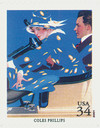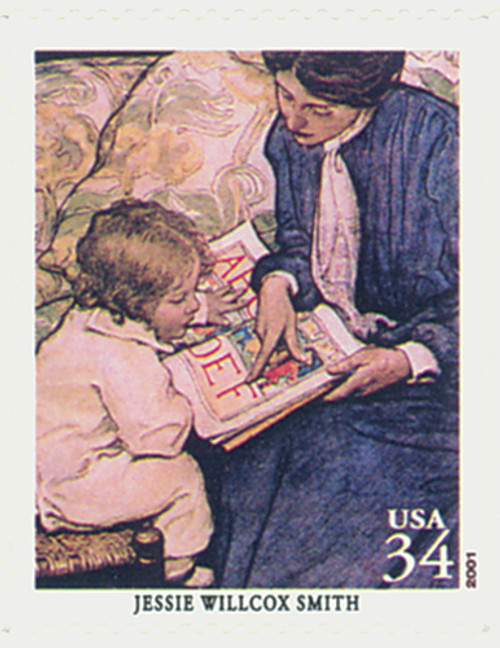
# 3502e - 2001 34c American Illustrator Coles Phillips
Coles Phillips
34¢ American Illustrators
City: New York, NY
Quantity: 125,000,000
Printed by: Avery Dennison Security Printing
Printing Method: Photogravure
Perforations: Serpentine die cut 11.25
Color: Multicolored
Birth of Coles Phillips
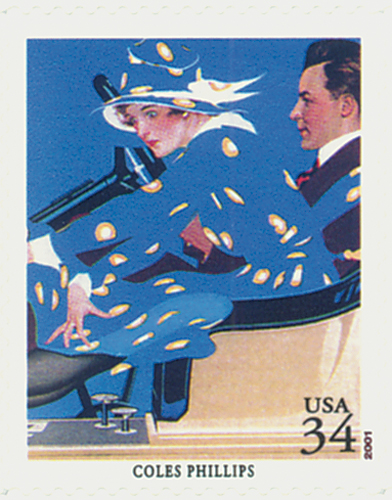
Clarence Coles Phillips was born on October 3, 1880, in Springfield, Ohio. Considered one of the leaders of the Golden Age of Illustration, he’s most well-known for his “fadeaway” girls, as pictured on his 2001 stamp.
Phillips enjoyed drawing as a child and went on to attend Kenyon College, where some of his illustrations were featured in the yearbook. He supported himself working as a clerk for the American Radiator Company. Phillips left Kenyon to go to New York City, where he attended the Chase School of Art for a short time and worked for the radiator company’s office there. However, Phillips lost his job after his boss discovered a caricature he’d drawn of him.

A colleague of Phillips showed the drawing to J.A. Mitchell, the publisher of Life Magazine. Mitchell liked it so much that he invited Phillips to interview for a job at Life. Phillips never went to the interview and instead went to work for an advertising agency. They created their illustrations in an assembly line, with one person drawing heads, another bodies, and so on. Phillips had a talent for drawing feet and ankles, so those were his responsibility.

Phillips opened his own advertising agency in 1906, but found that running the business left him little time to draw. So the following year, he finally went to see Mitchell, beginning an association with Life that lasted the rest of Phillips’s life. On April 11, 1907, Phillips had his first nationally published illustration in Life, a black and white centerfold.
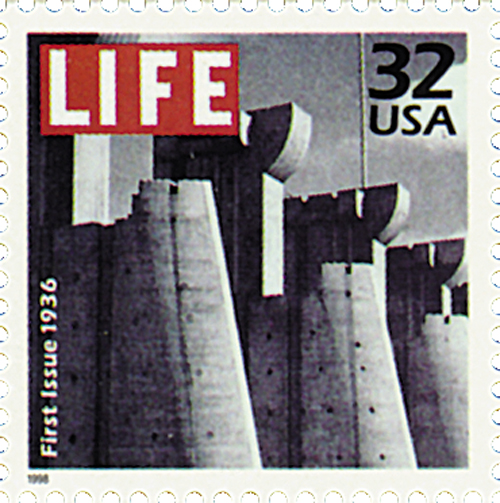
Over the next year, Phillips continued to produce black and white centerfolds for Life. Then in the spring of 1908, the magazine began planning new colorful covers to help increase readership. They asked Phillips if he had any interesting ideas for covers, and he did – the fadeaway. Phillips had first had the idea for the fadeaway a few years earlier. While visiting a tuxedo-clad friend playing a violin in a dark room, he realized that he could roughly distinguish his friend’s figure, even though he couldn’t see him clearly.
Phillips produced a cover illustration featuring his first Fadeaway Girl – a young girl feeding chickens, with the white of her dress and the chickens fading away into the white background. That cover debuted on February 20, 1908. Over the next four years alone, Phillips painted 54 covers for Life and one a month for Good Housekeeping. These covers helped make him internationally known and he began doing advertisements as well. Phillips worked with several advertisers for many years including Willy’s Overland automobiles, Oneida Community silverware, and Holeproof and Luxite hosiery.
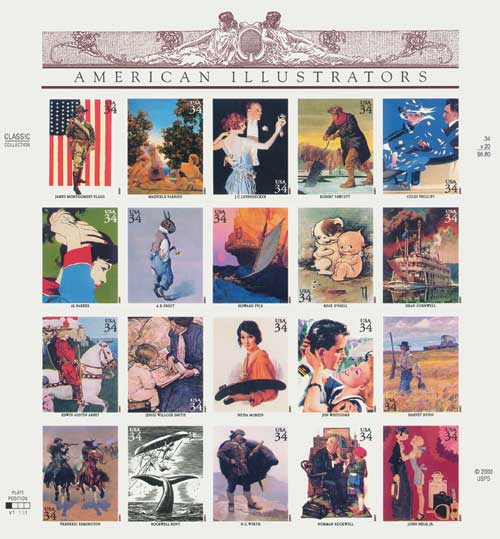
In addition to magazines, Phillips’s work appeared on postcards, posters, poster stamps, books, calendars, fans, and more. He also produced illustrations for the US Naval Academy’s yearbook.
Phillips was diagnosed with tuberculosis in 1924 and died on June 13, 1927.
Coles Phillips
34¢ American Illustrators
City: New York, NY
Quantity: 125,000,000
Printed by: Avery Dennison Security Printing
Printing Method: Photogravure
Perforations: Serpentine die cut 11.25
Color: Multicolored
Birth of Coles Phillips

Clarence Coles Phillips was born on October 3, 1880, in Springfield, Ohio. Considered one of the leaders of the Golden Age of Illustration, he’s most well-known for his “fadeaway” girls, as pictured on his 2001 stamp.
Phillips enjoyed drawing as a child and went on to attend Kenyon College, where some of his illustrations were featured in the yearbook. He supported himself working as a clerk for the American Radiator Company. Phillips left Kenyon to go to New York City, where he attended the Chase School of Art for a short time and worked for the radiator company’s office there. However, Phillips lost his job after his boss discovered a caricature he’d drawn of him.

A colleague of Phillips showed the drawing to J.A. Mitchell, the publisher of Life Magazine. Mitchell liked it so much that he invited Phillips to interview for a job at Life. Phillips never went to the interview and instead went to work for an advertising agency. They created their illustrations in an assembly line, with one person drawing heads, another bodies, and so on. Phillips had a talent for drawing feet and ankles, so those were his responsibility.

Phillips opened his own advertising agency in 1906, but found that running the business left him little time to draw. So the following year, he finally went to see Mitchell, beginning an association with Life that lasted the rest of Phillips’s life. On April 11, 1907, Phillips had his first nationally published illustration in Life, a black and white centerfold.

Over the next year, Phillips continued to produce black and white centerfolds for Life. Then in the spring of 1908, the magazine began planning new colorful covers to help increase readership. They asked Phillips if he had any interesting ideas for covers, and he did – the fadeaway. Phillips had first had the idea for the fadeaway a few years earlier. While visiting a tuxedo-clad friend playing a violin in a dark room, he realized that he could roughly distinguish his friend’s figure, even though he couldn’t see him clearly.
Phillips produced a cover illustration featuring his first Fadeaway Girl – a young girl feeding chickens, with the white of her dress and the chickens fading away into the white background. That cover debuted on February 20, 1908. Over the next four years alone, Phillips painted 54 covers for Life and one a month for Good Housekeeping. These covers helped make him internationally known and he began doing advertisements as well. Phillips worked with several advertisers for many years including Willy’s Overland automobiles, Oneida Community silverware, and Holeproof and Luxite hosiery.

In addition to magazines, Phillips’s work appeared on postcards, posters, poster stamps, books, calendars, fans, and more. He also produced illustrations for the US Naval Academy’s yearbook.
Phillips was diagnosed with tuberculosis in 1924 and died on June 13, 1927.





